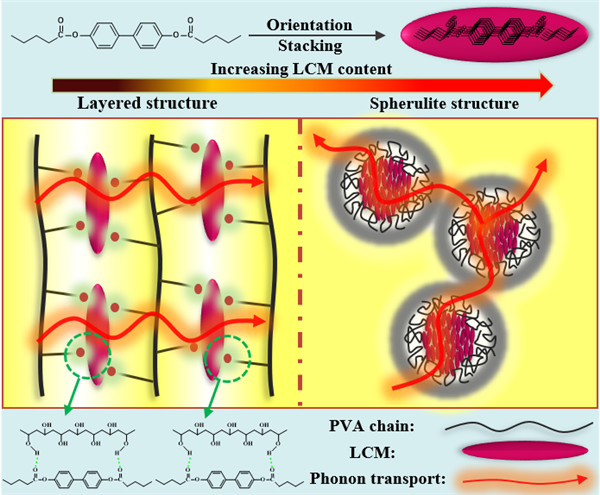Ying Li*, Changdan Gong, Chenggong Li, Kunpeng Ruan, Chao Liu, Huan Liu and Junwei Gu*. Liquid crystalline texture and hydrogen bond on the thermal conductivities of intrinsic thermal conductive polymer films. Journal of Materials Science & Technology, 2021, 82: 250-256. 2019IF=6.155.(1區材料科學Top期刊,中國科技期刊卓越行動計劃入選項目-重點期刊類項目)
(https://doi.org/10.1016/j.jmst.2021.01.017)
AbstractPolymer-dispersed liquid crystal (PDLC) films comprising polyvinyl alcohol (PVA) and liquid crystal monomer (LCM) were successfully obtained by the method of solution casting & thermal compressing. LCM was distributed orderly in PVA matrix by hydrogen bond interaction, to form PVA-LCM interpenetrating-layered networks. When the mass fraction of LCM was up to 35 wt%, the corresponding in-plane thermal conductivity coefficient (λ//) of PDLC film was significantly increased to 1.41 W m-1 K-1, about 10.8 times that of neat PVA (0.13 W m-1 K-1). High intrinsic λ// values of PDLC films were mainly attributed to the microscopic-ordered structures formed by ordered stacking of LCM, ordered arrangement of PVA chains, and their hydrogen bond interaction. This work would offer a new way to design and prepare novel intrinsic high thermal conductive polymers.通過溶液澆鑄和熱壓成型工藝將液晶單體(LCM)分散在聚乙烯醇(PVA)基體中,制備了液晶單體聚乙烯醇分散膜(PDLC)。LCM通過氫鍵作用均勻分散在PVA基體中,形成了PVA-LCM層狀互穿網絡結構。當LCM的用量達到35 wt%時,PDLC膜的面內導熱系數(λ//)高達1.41 W m-1 K-1,約為純PVA(0.13 W m-1 K-1)的10.8倍。PDLC膜的高λ//主要歸因于LCM層疊形成的微觀有序結構、PVA分子鏈的規整排列以及LCM與PVA分子鏈間的氫鍵作用力。這項工作為設計和制備本征型高導熱高分子材料提供了新的途徑。
